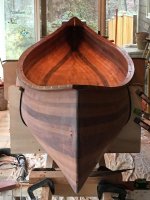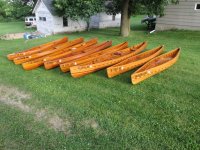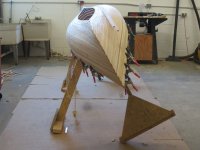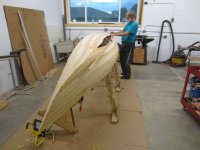I have a question for the experienced strip builders. So, having begun the process of considering a solo tripping canoe project, I'm wondering about orienting the first strip: parallel to the waterline or installed with 'some' curvature (but not following the sheer completely). Aesthetic as well as practical concerns are both in play here.
I'm wondering what effect there may be on the stripping process if I install parallel to the waterline. Will the shape of the "football" in the bottom of the canoe be odd-looking? Will the strips acquire some strange curve where they intersect the bottom of the stem area (although I'm planning on going stemless)?
In the event that the hull shape makes a difference here, I'm considering several designs: the Winters kite/osprey; the Kunz 38 Special (thanks to Jim Dodd's glamorous photos on his posts!); or the Northwest Merlin; the Bear Mountain Freedom solo for example(s).
I do know that wooden boats of all types benefit visually from the sweep of the sheer line, but aesthetically does a 'competing' strip line detract from this? I have no plans for any accent striping other than perhaps placing relatively darker strips as each strip nears the bottom- in other words, light color at the sheer progressing to darker at the bottom.
Thanks in advance for your thoughts.
Pat
I'm wondering what effect there may be on the stripping process if I install parallel to the waterline. Will the shape of the "football" in the bottom of the canoe be odd-looking? Will the strips acquire some strange curve where they intersect the bottom of the stem area (although I'm planning on going stemless)?
In the event that the hull shape makes a difference here, I'm considering several designs: the Winters kite/osprey; the Kunz 38 Special (thanks to Jim Dodd's glamorous photos on his posts!); or the Northwest Merlin; the Bear Mountain Freedom solo for example(s).
I do know that wooden boats of all types benefit visually from the sweep of the sheer line, but aesthetically does a 'competing' strip line detract from this? I have no plans for any accent striping other than perhaps placing relatively darker strips as each strip nears the bottom- in other words, light color at the sheer progressing to darker at the bottom.
Thanks in advance for your thoughts.
Pat





